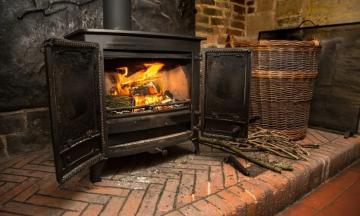
Tips To Maximize Heat Efficiency in Your Wood-Burning Stove
Using a stove that generates heat can be a smart strategy to reduce fossil fuel consumption and save on heating costs. But how can you ensure that your stove provides the best energy savings? Here are some tips to maximize heat efficiency in your wood-burning stove.
Keep the Stove and Chimney Clean and Ensure Proper Ventilation
Cleanliness and proper ventilation are crucial. A clean stove, air vents, and chimney allow for better airflow, which is essential for efficient combustion. Regular cleaning removes soot and creosote buildup, preventing chimney fires and ensuring that air can circulate freely. Moreover, adequate ventilation is vital for safety and fuel efficiency. Proper ventilation ensures that your wood burns evenly and completely, releasing the maximum amount of heat from your fireplace stove.
Use the Right Wood Type and Size
Not all wood is equal when it comes to fueling your stove. Maple, oak, and birch are hardwoods, and they burn longer and produce more heat compared to soft wood like cedar or pine. For optimal efficiency, use seasoned wood dried for at least six months to a year. Wood that's too green or moist can lead to incomplete combustion, producing less heat and more creosote.
Additionally, consider the size of the wood. Logs that are too large may not burn completely, while those that are too small could burn too quickly. Finding the right balance is key.
Check Seals Regularly
An often-overlooked aspect of stove maintenance is checking the seals. Over time, the seals around the stove door and ash pan can deteriorate, allowing heat to escape. Inspect these seals regularly and have them replaced if they're worn out. This simple step can significantly improve your stove's heat retention and efficiency.
Add a Stove Pipe Thermometer
A stove pipe thermometer is an invaluable tool for any wood stove owner. It helps you monitor the temperature of your stove's exhaust, which is a good indicator of overall efficiency. By keeping an eye on the temperature, you can adjust your burning practices to stay within the optimal range, ensuring your wood burns cleanly and efficiently.
Use a Stove Fan
Lastly, consider investing in a stove fan. These handy devices sit atop your stove and distribute warm air throughout the room evenly. By improving air circulation, a stove fan can help you achieve a more consistent and comfortable temperature, making your wood stove's heat output go further.
Maximizing the heat efficiency of your wood-burning stove is a straightforward yet impactful way to enhance your home's warmth and comfort and save on energy costs. By following these tips, you'll not only enjoy a cozier living space but also contribute to a more sustainable and cost-effective heating solution.

